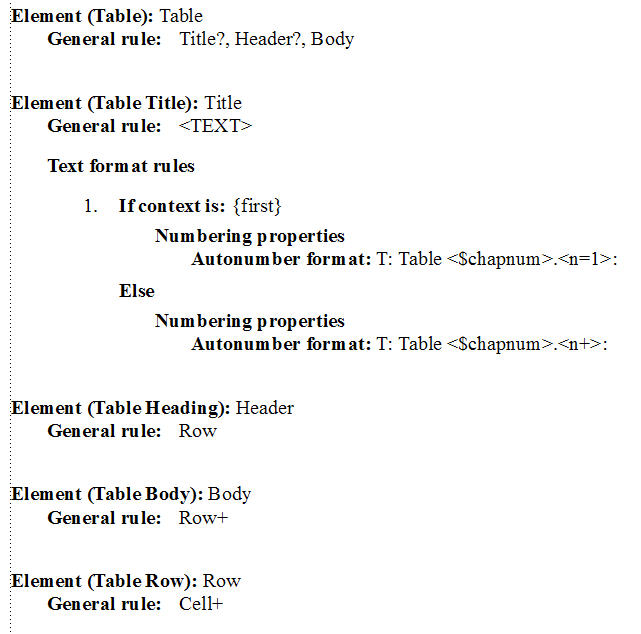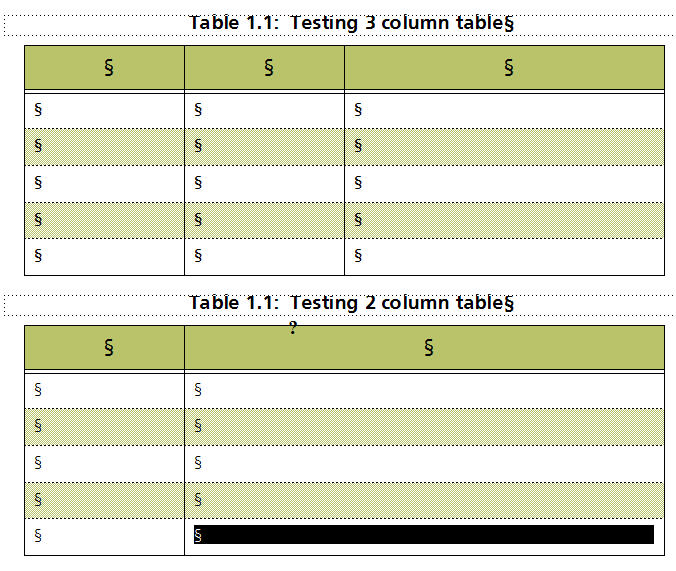Copy link to clipboard
Copied
Hello,
I'm building my EDD in FM9 and I'm trying to set up the Table Numbering. As far as I can tell, I've built it up the same way as all my other numbered sequences (lists, headers, etc.) but it's not working.
Here's the EDD:

And here's what happening in the document:

I have this sinking feeling that I'm missing something blindingly obvious, but I just can't see it. If anyone can help me out, I'd appreciate it!
 1 Correct answer
1 Correct answer
The {first} indicator means the "first ELEMENT inside the parent element" NOT the first instance in the document. Your construction is used typically in numbered lists to select the first item element inside the list, and one can have more than one list in a document.
So, assuming you want the tables to restart their numbering from the beginning of each document (chapter) in a book, your autonumber format should be this:
Autonumber format: T:Table <$chapnum>.[<n+>]
The square brackets surrounding
...Copy link to clipboard
Copied
In the EDD that I took over (I did not set this up), the table autonumbering is only mentioned in the Title element in the parent element Procedure. Our documents contain several Procedure level elements (Chapters, if you will) and each procedure has a title element. Since we want the table number sequence to be reset for each Procedure, there is a PropertiesNumbering element in the Text Format Rules for the Title element. The child of the PropertiesNumbering EDD element to be used here is AutonumberFormat. Here there is a text entry T:< =0>< =0> which apparently resets the Table and the Figure counters when each Procedure Title occurs. This is the only reference to the T: in the edd except for two lines in the Comments section T: Figure Captions (template) and T: Table Titles (template). Also, the Table itself is defined in the EDD, under InitialTableFormat | AllContextsRule as a "RegularTable". This may have some meaning but I could not find it in any of the documentation.
As far as how the numbering is defined in the table itself, in the EDD, there is no mention of table numbering or numbering format. That's what leads me to believe that "RegularTable" might have something to do with that.
It's definitely different than setting up numbers for lists and the User Guide doesn't seem to clarify this topic for me. I would appreciate a more definitive explanation on this topic.
I hope that this is helpful is some way.
Copy link to clipboard
Copied
Chuck,
For what it is worth, the table format does not set the table numbering.
My guess is that the numbering is set by the paragraph style applied to the table's title and the figure's caption. Look there and then look at the autonumber format for each style. You may find that one looks like this
T:<n+>< >
and the other looks like this
T:< ><n+>
The author may be using multiple counters in the formats. The empty < > indicates that the counter is NOT displayed NOR incremented. In other words, the author turns one counter on for figures and the other counter on for tables.
This is speculation but may help to find out what is going on.
Copy link to clipboard
Copied
The {first} indicator means the "first ELEMENT inside the parent element" NOT the first instance in the document. Your construction is used typically in numbered lists to select the first item element inside the list, and one can have more than one list in a document.
So, assuming you want the tables to restart their numbering from the beginning of each document (chapter) in a book, your autonumber format should be this:
Autonumber format: T:Table <$chapnum>.[<n+>]
The square brackets surrounding <n+> are NOT to be typed; they are there to signify that this is an element,a numberPlus element, that you insert into the EDD from the Elements Catalog. If this is to be applied for all tables in your book, then this is embedded in an All Contexts rule.
Furthermore, if now or in the future you want to use your EDD in a single document, not a book, which has no chapters, then you can create another context rule that looks for whatever you use to indicate no chapter numbering and changes the autonumber format to T:Table [<n+>]
Note that n+ is a paragraph number. So, in your book file you set the paragraph numbering for each document to start at 1.
Hope this helps.
Copy link to clipboard
Copied
Aaahh... still learning all these ins and outs. That did it, thank you!